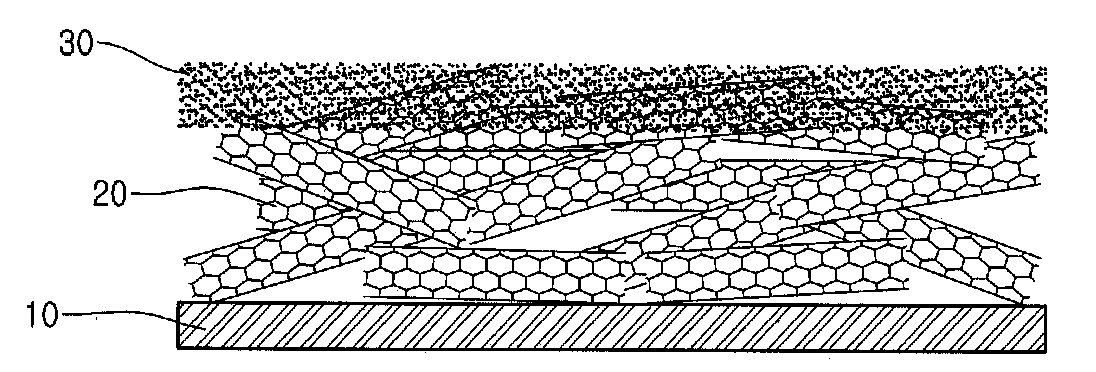Carbon nanotube transparent electrode and method of manufacturing the same
a technology of carbon nanotubes and transparent electrodes, applied in the direction of transportation and packaging, synthetic resin layered products, coatings, etc., can solve the problems of reducing the stability of the application process of cnt transparent electrodes to devices, reducing the roughness or film uniformity of surfaces, and reducing the conductivity of cnt transparent electrodes. , to achieve the effect of enhancing the conductivity of cnt transparent electrodes, reducing electrical conductivity, and reducing electrical conductivity
- Summary
- Abstract
- Description
- Claims
- Application Information
AI Technical Summary
Benefits of technology
Problems solved by technology
Method used
Image
Examples
experiment 1
Characteristic Change Depending on Cover-Layer Formation Ratio
[0073]An experiment was carried out measuring characteristic changes depending on the cover-layer formation ratio with respect to the entire layer. Here the electrode type was the upper-cover-type, and PET was used as the substrate.
[0074]The cover-layer formation ratio can be defined as follows. First, the total weight of the entire layer can be represented by Expression 1.
Total weight of CNT in entire layer=weight of CNT layer+weight of CNT present in the cover layer Expression 1
[0075]For reference, since the CNT layer is composed of CNT only after washing, the weight of the CNT layer is the weight of the CNT in the CNT layer. Since the cover layer is composed of CNT (conductive particle) and polymer, the weight of the cover layer can be calculated by adding the weight of polymer and the weight of CNT.
[0076]The ratio of the cover layer can be represented by Expression 2.
Ratio of Cover Layer (%)=[weight of CNT present in...
experiment 2
Characteristic Change Depending on Electrode Type
[0081]The ratio of cover layer was set to be 37%, which is approximate to the ratio of cover layer of Experiment 1 (38%), and the electrode types on the substrate (PEN) were set to be lower-cover-type and upper-and-lower-cover-type, differently from that of Experiment 1. In the case where the upper-and-lower-cover-type was adopted, 7.4% of 37% was set to correspond to the cover layer covering the upper portion of the electrode. Table 2 shows the experiment results.
TABLE 2SheetRoughnessresistanceTrans-(RMS)(Rs)mittanceLower-cover-type7.489 nm534.77 Ω / sq87.0%electrode [ratio ofcover layer - 37%]Upper-and-lower-5.824 nm525.71 Ω / sq87.4%cover type electrode[ratio of cover layer -37%; upper portion7.4% + lower portion29.6%]
[0082]As shown in Table 2, when the lower-cover-type electrode was used, the roughness decreased to 7.489 nm, and the sheet resistance decreased to 534.77 Ω / sq. And, when the upper-and-lower-cover-type electrode was used,...
experiment 3
Change in Composition of Cover-Layer Forming Solution
[0083]The ratio of cover layer was set to be 31%, the type of the polymer in the cover-layer forming solution was replaced with polystyrene sulfonic acid (PSS) and Nafion®, the electrode type was set to be lower-cover-type, and the substrate was PET substrate. Table 3 shows the experiment results. For reference, Table 3 also shows the case where the ratio of cover layer is 0% and the case where polyacrylic acid (PAA) is used and the ratio of cover layer is 37%.
TABLE 3Ratio of CoverRoughnessSheet resistanceLayer(RMS)(Rs)Transmittance 0%10.700 nm872.4 Ω / sq89.4%37% (PAA used)10.257 nm471.3 Ω / sq88.5%37% (PSS used)10.459 nm478.1 Ω / sq89.1%37% (Nafion ®10.440 nm750.0 Ω / sq89.7%used)
[0084]As shown in Table 3, when PSS was used, the sheet resistance and the roughness were 478.1 Ω / sq and 10.495 nm, respectively. When Nafion® was used, the sheet resistance was 750.0 Ω / sq and the roughness was 10.440 nm. The sheet resistance in the case using ...
PUM
| Property | Measurement | Unit |
|---|---|---|
| Fraction | aaaaa | aaaaa |
| Fraction | aaaaa | aaaaa |
| Weight | aaaaa | aaaaa |
Abstract
Description
Claims
Application Information
 Login to View More
Login to View More - R&D
- Intellectual Property
- Life Sciences
- Materials
- Tech Scout
- Unparalleled Data Quality
- Higher Quality Content
- 60% Fewer Hallucinations
Browse by: Latest US Patents, China's latest patents, Technical Efficacy Thesaurus, Application Domain, Technology Topic, Popular Technical Reports.
© 2025 PatSnap. All rights reserved.Legal|Privacy policy|Modern Slavery Act Transparency Statement|Sitemap|About US| Contact US: help@patsnap.com



